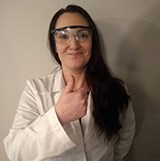Claire German

Forensic Anthropology: What a Body Can Tell Us After Death
Submitted to Dr. Jennifer Fain-Thornton for Human Anatomy and Physiology 1 (BIOL-210)
Summary:
My signature assignment is about what can be known about a person by observing their remains after death.
General Education Connections
- Communicate ideas in written, oral and other modes as appropriate to a situation and audience
- Apply quantitative and scientific reasoning skills relevant to a field of study
- Employ various thinking strategies to develop well-reasoned judgments
- Evaluate sources of information for accuracy, relevance and reliability
- Cultivate intellectual and ethical practices that promote the wellness of self, community and environment
- Identify their roles as global citizens in a multicultural country and world
Writing this paper allowed me to communicate my ideas. Knowledge of medical terms in the study of human anatomy and physiology helped me to communicate them to the appropriate audience. I used critical thinking and scientific reasoning when evaluating my research in order to answer the questions on the rubric. I realized the multicultural nature of the world when learning about ethics in forensic anthropology regarding the remains of indigenous peoples.
Challenges
My main challenge in this project was in researching facial reconstruction of the skull. Although science has made many advancements, this is still an area of some uncertainty and error. I explained on my paper how certain fleshy parts of the face completely decompose and may leave little to no clues as to what the person originally looked like.
Application
My field of study is nursing. I realized that, like nurses, forensic anthropologists help people. Although they may work with the dead, the work they do can help living loved ones. Their work with law enforcement can also assist to bring justice in cases where a crime has been committed.